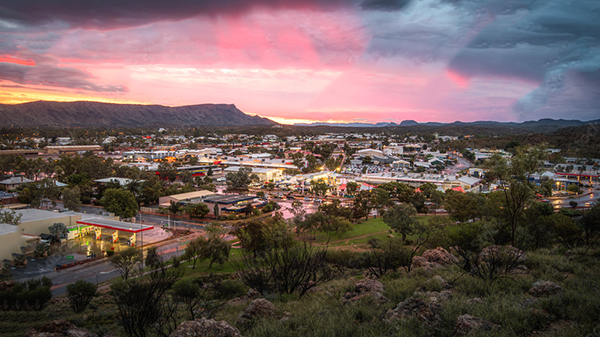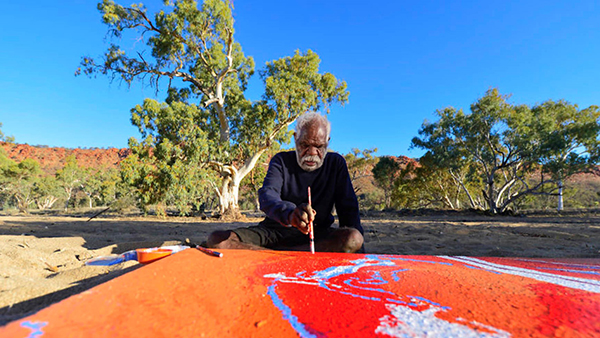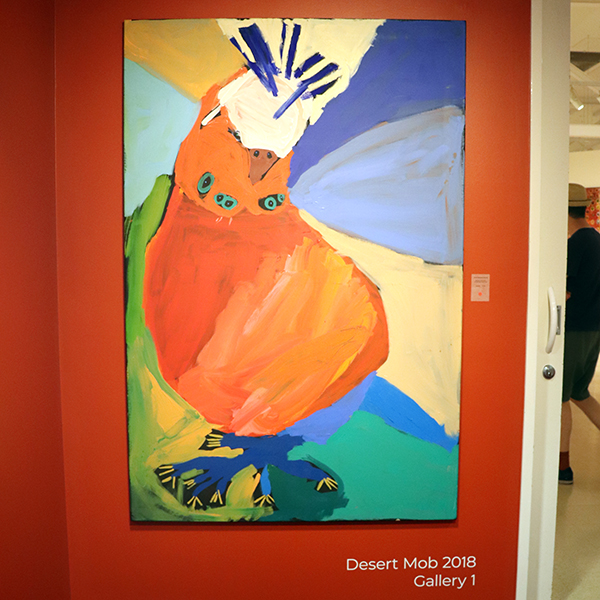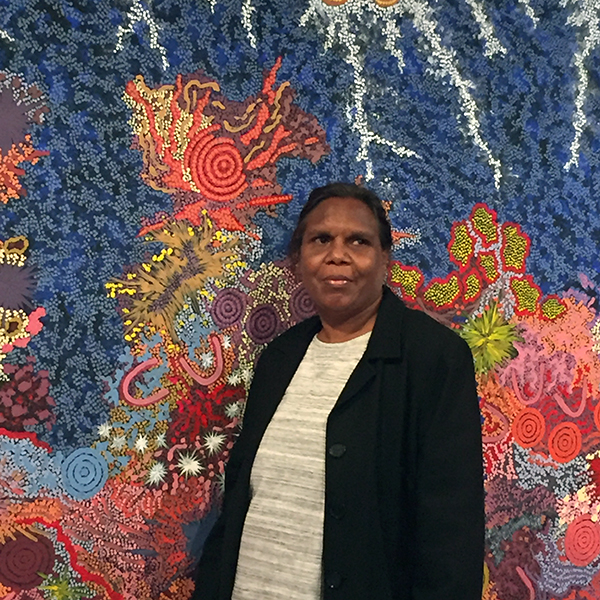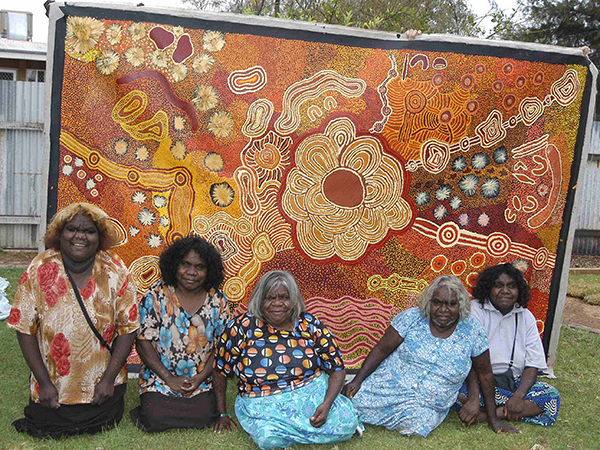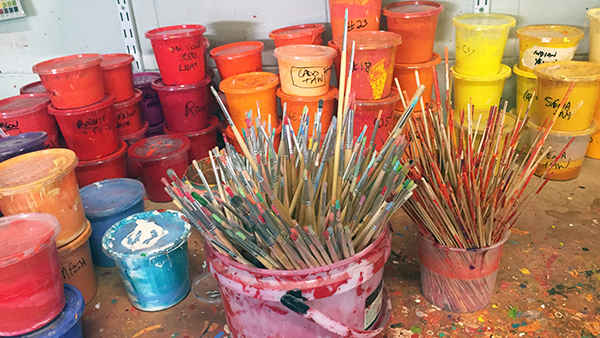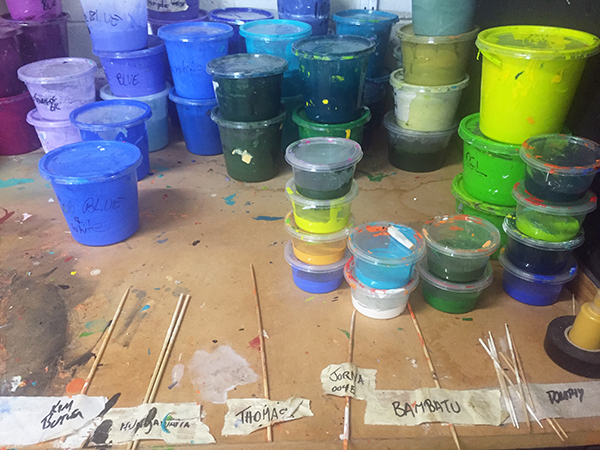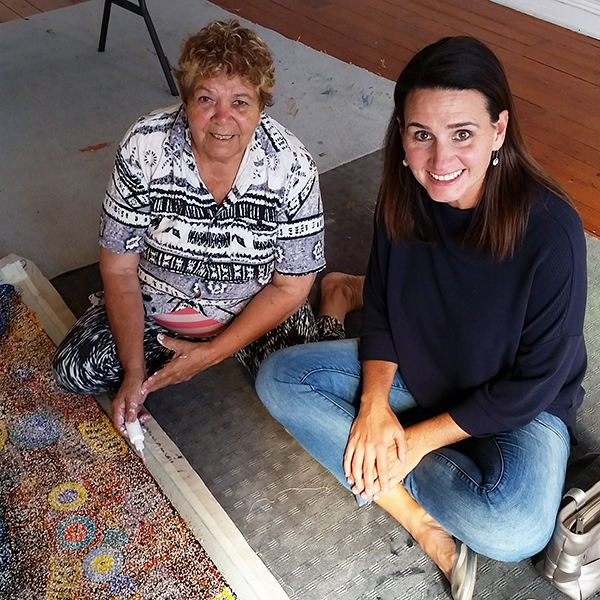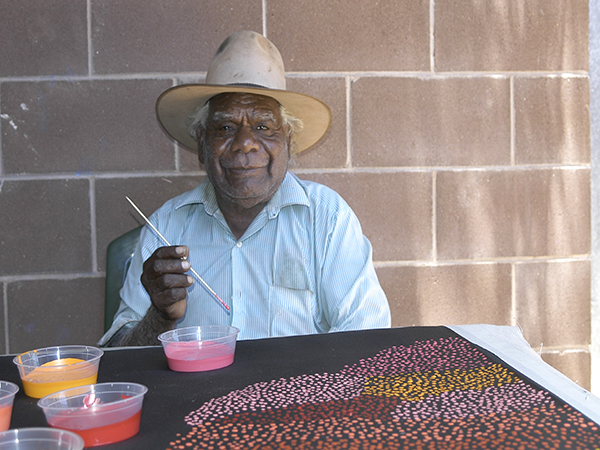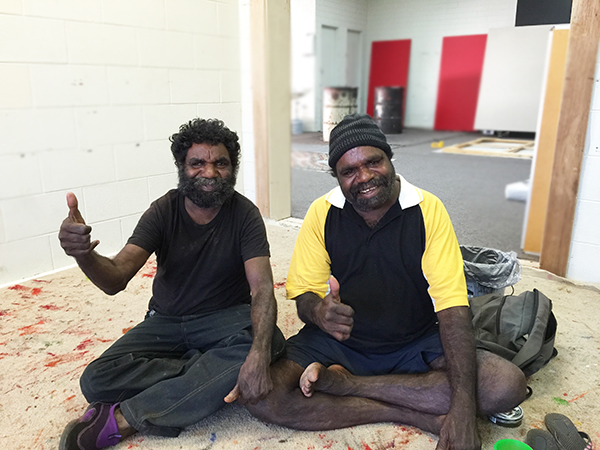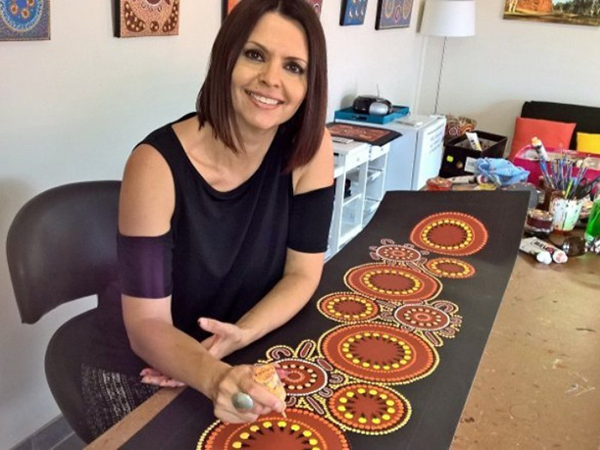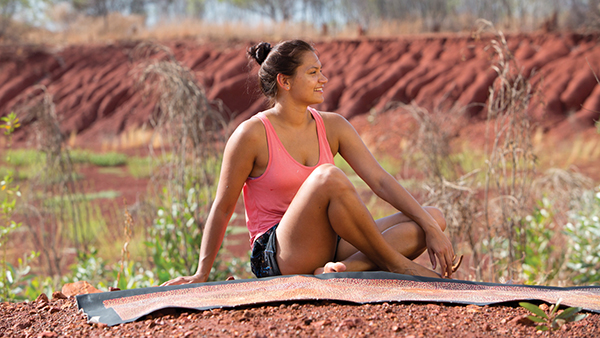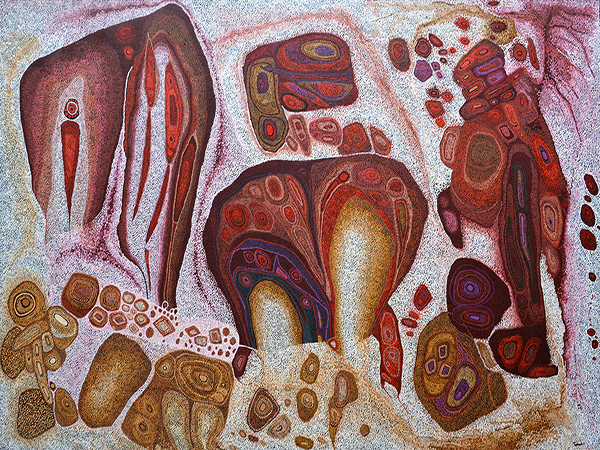Please enjoy our wide range of captivating and gloriously diverse Aboriginal artworks from the Alice Springs region of Central Australia. This area has a special place in the hearts of our gallery directors. Over decades of living and working in the region, they have developed enduring connections with artists and their art.
View Alice Springs Artworks
Despite being a small desert town in the heart of Australia, Alice Springs is a vibrant creative and culturally rich community. It is also considered the worldwide capital of Aboriginal art and people come from all over the world to see it at its source.
Topics on this Page
Geography + Cultural Significance | The Vibrant Art Industry |Our History in the Region | The Artists
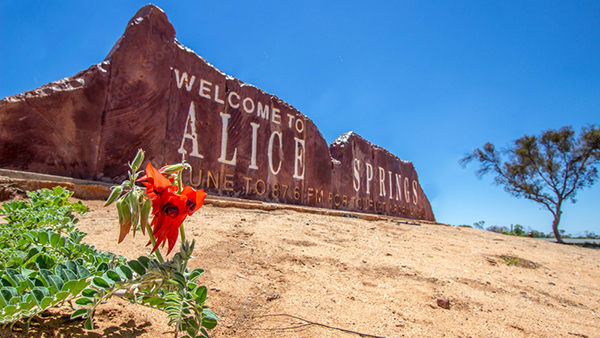
Geography and Cultural Significance of Alice Springs
Location
Alice Springs is a town in the Northern Territory and is in the ‘red centre’ of Australia, halfway between Darwin and Adelaide. It is nestled between the East and West MacDonnell Ranges, a striking mountain range which is notched with waterholes, gorges, and chasms. The area is a little oasis from the harsher desert landscape found in the neighbouring central and western deserts.
Cultural Significance
The traditional inhabitants, the Arrernte people, call the site Mparntwe (pronounced M-ban-tua). Mparntwe is the site of the Caterpillar and Wild Dog Dreamings.
The Yeperenye (Caterpillar) Dreamtime story explains how the stunning MacDonnell ridges were created. There are many sites of critical importance to the Arrernte people dotted along the ranges, including rock carvings marked into sandstone that are thousands of years old.
Why is Alice Springs important to Aboriginal Art?
Alice Springs is also the place where art from the western desert community of Papunya was first marketed in the 1970s. From humble beginnings, the artists of Papunya are now known as the founders and ‘Masters’ of the Aboriginal Art Movement.
In the years since 1971, the central desert region has become nationally and internationally acclaimed for producing some of the country’s biggest names in Aboriginal art. The town has an outstanding collection of art galleries, cultural museums, and events, making it a popular destination to interact with and learn more about the area’s rich culture and visual heritage.
The epicentre of Aboriginal culture + art in the region
There are also a huge range of day trips available to visit neighbouring communities and stunning sites of natural beauty and cultural significance. This gives visitors the unique opportunity to easily explore the rich diversity of Aboriginal art and culture in the region.
A Vibrant Creative Hub of Activity
Why is Alice Springs an arts hub?
The town has become a creative hub of activity and is dotted with numerous art centres, Aboriginal corporations, art galleries, artist run initiatives and private studios. The main street, Todd Mall, is a bustling pedestrian walkway lined with galleries, outdoor markets and lawns frequented by independent artists displaying their wares.
Artists and art lovers from across Australia and the world descend on the town for annual festivals and events. Highlights include Desert Mob, the Alice Prize and The Beanie Festival.
Desert Mob
The Desert Mob Festival brings together the art and culture of First Nations artists from millions of square kilometres of desert Country. Over a four-day period, there are exhibitions, art markets, lectures, and events all around town.
We love to visit town when the festival is on. It’s a great opportunity to view new developments in Aboriginal art. It's also wonderful time to meet and reconnect with artists from remote communities, listen to their stories and share their culture in the heart of their Country.
The Alice Prize
The biennial Alice Prize is one of Australia’s oldest and most prestigious regional contemporary art prizes. It is also considered the most significant national contemporary art prize held in the Northern Territory.
Gabriella Possum Nungurrayi, eldest daughter of renowned artist Clifford Possum Tjapaltjarri, won the award at the tender age of 16. She has since become one of the most eminent Indigenous artists living and working today.
Beanie Festival
Beanies may not be the first thing that comes to mind when packing for a holiday in Central Australia, but winters in Alice Springs are cold and night temperatures drop below 0°C. The Beanie Festival started over 25 years ago as a small party selling beanies crocheted by Aboriginal women in remote communities.
Since then, it has become a multi-day celebration where Aboriginal and non-Aboriginal artists share their culture and exhibit together. The festival’s aims have always been to develop Aboriginal women’s textiles, promote women’s culture and identify the beanie as a regional art form. It also aims to promote handmade textile arts.
Our Close Affiliation with the Artists of Alice Springs
Our journey to becoming one of the largest Indigenous Australian art galleries is unique. It flourished out of a passion to share Australia’s ancient visual stories painted in a powerful and contemporary vein. The story of how the current owners and directors of Kate Owen Gallery began their Aboriginal art career starts in Alice Springs.
In 2008, after building close relationships with artists living and working in town, our director opened a modest space where artists and their families could express their stories.
As the years went by and more relationships were formed, the studio moved to a large spacious complex which allowed artists from town and outlying communities to work in a safe and comfortable space.
It also provided the opportunity to store ample supplies of high-quality linen and a kaleidoscope of paints that artists could use in the studio or in the comfort of their own homes.
Art from the studio was being displayed in some of the most reputable and long established commercial Aboriginal art galleries across the country.
Occurring concurrently, strong relationships were being formed with some of the finest art centres, art galleries and independent artists in the region. We became members of the Aboriginal Art Association of Australia, an organization committed to upholding the rights of Indigenous artists since 1999.
As more and more artists wished to paint at the studio and supply of art increased, we opened a gallery space on Todd Mall.
When Kate decided to retire from the gallery in 2013, the current directors integrated the private studio in Alice Springs with Kate Owen Gallery. It created Australia’s largest vertically integrated Aboriginal art studio and gallery.
Our longstanding, direct relationship with many of the artists whose works we market and our deep understanding of their art making practice continues to be one of our key points of difference.
To give visitors the opportunity to experience the creative energy and talent that our staff experiences firsthand in Alice Springs, the gallery initiated a regular artist in residence programme in 2015.
This programme sees the Gallery sponsoring Indigenous artists to travel from all over Australia to come and spend one to three weeks painting in the gallery.
Highlights have included Barbara Weir (pictured above) with her family members Lizzie and Teresa Pwerle, and Warlukurlangu Artists Alma Nungurrayi Granites, Julie and Sabrina Nangala, Chantelle Nampijinpa Robertson, and Christine Napanangka Michaels. To find out more about our upcoming events, join our mailing list.
Aboriginal Artists from Alice Springs
Being the third largest town in the Northern Territory, many Indigenous Australian people visit regularly to access its services. Artists from across all the desert regions and beyond have chosen to make Alice Springs their base while still making regular trips back to community and outstations to be with relatives. This is a vital element of continuing their connection with culture and contributing to family and community.
There are many models under which Aboriginal artwork is produced in Central Australia and beyond. Some artists choose to work for Aboriginal owned and controlled art centres. Others prefer to produce art independently and work directly with galleries and dealers. Many chose to do both. We honour the right of Indigenous artists everywhere to create their works where, how and with whom they wish, and to market their art via the channel of their choice.
Esteemed Utopian artists Barbara Weir and her daughter, Charmaine Pwerle, are good examples of this multi-faceted approach to their art practice, their culture and their community. They live in Alice Springs and have a studio space at their home where they generally paint and market their work from.
At other times, they chose to work in privately run studios with other family members who are in town. Barbara and Charmaine regularly return home to visit family, connect with culture and contribute to their community. You can read all about our day in Utopia with Barbara Weir on our blog.
It is a similar story for many western desert artists such as Pintupi brothers Walala and Thomas Tjapaltjarri.
Warlpiri sisters Julie and Sabrina Nangala Robertson divide their time between town and the Community of Yuendumu and paint for both private art studios and Warlukurlangu Artists.
Several artists from as far away as the APY Lands in South Australia such as Patricia Baker and Clarise Tunkin follow a similar model.
An Indigenous artist who has called Alice Springs home most of her life is Kathleen Buzzacott. Her beautifully intricate dot paintings depict fond childhood memories hunting for bush tucker with family. She runs her own small gallery just outside of town as well as displaying her art in galleries around Australia.
Local Arrente artists such as Peter Mbitjana Palmer and Selma (Nunay) Coulthard Nakamarra work independently as well as through local community art centres such as Iltja Ntjarra (Namatjira School of Watercolour art).
Being the epicentre of Aboriginal art, many Indigenous and non-Indigenous artists travel to the region for inspiration. This has been the case for the King Sisters, Helen McCarthy Tyalmuty and even Kate Owen herself!
Helen McCarthy Tyalmuty in particular had an incredible creative explosion after spending an extended period of time living and working in the region in 2016 -2017. The paintings are bold, powerful, and reference the incredible shapes and mineral rich colours found in the natural landscape.
This piece by Helen is titled Kata Tjuta (The Olgas) and is her artistic response to her visit to this sacred site to the local Anangu people. At the same time, Helen continued to paint her Country and Dreamings but with a renewed vigour – such is the potency of this magical region of Australia.
We hope you enjoy our expansive range of Indigenous Australian art from this special part of Australia. For more information on any of the artworks listed, please contact us and one of our friendly & informative art consultants will get back to you shortly.
View Alice Springs Artworks

